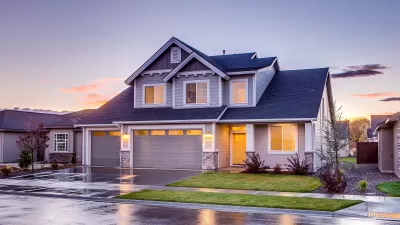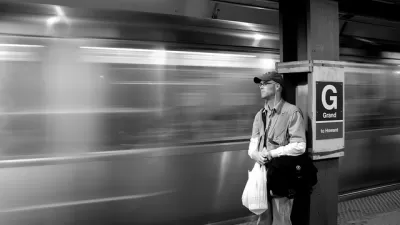According to a new report, U.S. transit ridership increased to 10.5 billion rides in 2012 - a 1.5% increase over 2011, despite transit shutdowns and reductions caused by Superstorm Sandy. High gas prices, and their volatility, was a major cause.
USA Today reporter Larry Copeland also pointed to the importance of the improving economy (more people going to work) and changing demographics as a reason for transit's growing popularity, "especially among Baby Boomers, empty-nesters and Millennials, who total about 150 million people."
As for the other reason, American Public Transportation Association President and CEO Michael Melaniphy "says the increase in transit ridership was driven, at least partly, by high gas prices, the volatility of those prices" in addition to the "nation's changing demographics."
The gas price explanation for increased transit ridership is not shared by a State Smart Transportation Initiative report posted here that analyses declining vehicle-miles-traveled. Many reasons are given while fuel prices are categorically rejected.
Copeland cited the Sound Transit light rail in Washington state as an example of the increased ridership. It "soared 12% last year to just over 28 million — a record in the agency's 14-year history, spokesman Bruce Gray says."
Why did 2008 set the record? Americans were unprepared for gas prices over $4.00 gallon. A better comparison for the record might be "the second highest ridership since 1957" according to the APTA press release.
If transit is going to keep up with the increased demand, additional funding will be needed - and the news is good there, according to the press release:
Melaniphy also pointed out that more Americans are supporting public transportation investment, as evidenced by the large number of transit-oriented ballot initiatives that passed in 2012. “Last year 49 out of 62 transit-oriented state and local ballot initiatives passed,” said Melaniphy. “That means there was a nearly 80 percent passage rate. This extremely high rate of success demonstrates how important public transportation is to people and to communities.”
The press release also breaks down the ridership increase into four transit modes:
- Light rail (modern streetcars, trolleys, and heritage trolleys) ridership increased 4.5 percent with 21 out of 28 transit systems reporting increases.
- Heavy rail (subways and elevated trains) ridership increased by 1.4 percent across the country as 10 out of 15 transit systems reported increases.
- Commuter rail ridership increased by 0.5 percent as 18 out of 28 transit systems reported increases.
- Large bus systems reported an increase of 1 percent and 29 out of 38 large bus systems reported increases.
Curtis Tate of McClatchy Newspapers points out that the improving economy is key to transit usage - and that exposes why not all transit systems are posting ridership increases. "About 60 percent of transit trips are to and from work, according to the public transportation association".
(W)hile many transit systems posted large gains, others saw a decline, reflecting the unevenness of the economic recovery. And declines in the state, local and federal tax revenues that support transit systems have forced many of them to cut back service.
FULL STORY: Public transportation hits 10.5B rides in 2012

Planetizen Federal Action Tracker
A weekly monitor of how Trump’s orders and actions are impacting planners and planning in America.

Map: Where Senate Republicans Want to Sell Your Public Lands
For public land advocates, the Senate Republicans’ proposal to sell millions of acres of public land in the West is “the biggest fight of their careers.”

Restaurant Patios Were a Pandemic Win — Why Were They so Hard to Keep?
Social distancing requirements and changes in travel patterns prompted cities to pilot new uses for street and sidewalk space. Then it got complicated.

Platform Pilsner: Vancouver Transit Agency Releases... a Beer?
TransLink will receive a portion of every sale of the four-pack.

Toronto Weighs Cheaper Transit, Parking Hikes for Major Events
Special event rates would take effect during large festivals, sports games and concerts to ‘discourage driving, manage congestion and free up space for transit.”

Berlin to Consider Car-Free Zone Larger Than Manhattan
The area bound by the 22-mile Ringbahn would still allow 12 uses of a private automobile per year per person, and several other exemptions.
Urban Design for Planners 1: Software Tools
This six-course series explores essential urban design concepts using open source software and equips planners with the tools they need to participate fully in the urban design process.
Planning for Universal Design
Learn the tools for implementing Universal Design in planning regulations.
Heyer Gruel & Associates PA
JM Goldson LLC
Custer County Colorado
City of Camden Redevelopment Agency
City of Astoria
Transportation Research & Education Center (TREC) at Portland State University
Camden Redevelopment Agency
City of Claremont
Municipality of Princeton (NJ)





























